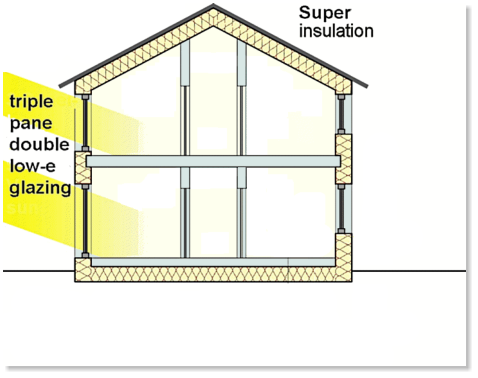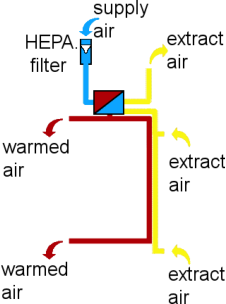




PassivHaus Basics













Basic Principles
The Passivhaus standard is sometimes confused with more
generic approaches to passive solar architecture, with which
it shares some common principles. Where the Passivhaus
standard differs from more generic concepts, is in its ability to
reduce the permitted space heating demand and primary
energy consumption. It can therefore be considered both as a
robust energy performance specification and a holistic low
energy design concept. In a Passivhaus house, thermal
comfort is achieved to the greatest practical extent through
the use of passive measures listed below which can be
applied not only to the residential sector but also to
commercial, industrial and public buildings.
•
Good levels of insulation with minimal thermal bridges
•
Passive solar gains and internal heat sources
•
Excellent level of airtightness
•
Good indoor air quality, provided by a whole house
mechanical ventilation system with highly efficient heat
recovery
There are no strict requirements with respect to domestic hot water, lighting and appliance consumption. The standard
imposes an overall limit on the primary energy consumption which promotes energy efficiency in all of these areas. Use of
Solar heat collection and/or Ground source heat collection is optional. The Passivhaus standard can be applied not only to
residential dwellings but also to commercial, industrial and public buildings. This has led to the following functional definition of
a Passivhaus. “A Passivhaus is a building, for which thermal comfort can be achieved solely by post-heating or post-cooling
of the fresh air mass, which is required to achieve sufficient indoor air quality conditions – without the need for additional
recirculation of air.” ...meaning the heating requirement in a Passivhaus is reduced to the point where a traditional heating
system is no longer considered essential. Cooling is also minimised by the same principles and through the use of shading
and in some cases via the pre-cooling of the supply air. Night purging and the use of natural cross-ventilation through open
windows is encouraged during the summer months.
PassivHaus Basics
















